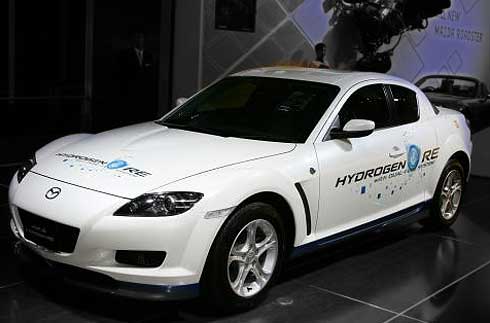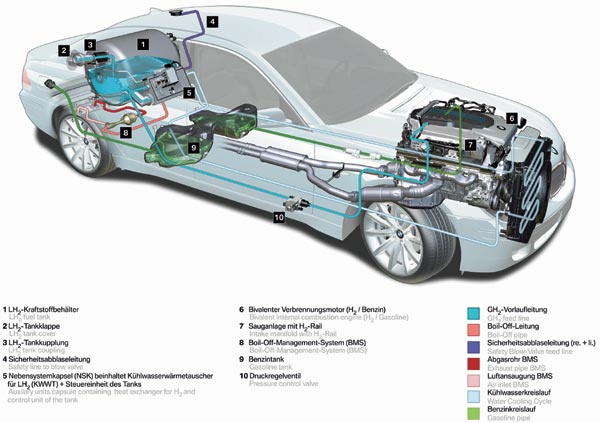As the news media likes to discuss daily, there are many risks to hydrogen fuel vehicles. Not the least of which is the cost effective replacement of tanks at refueling stations the world over. Not the least of which is the cost effective replacement of tanks at refueling stations the world over.

With those costs, it'll be many, many years, perhaps decades, before the rest of the world followed suit and made the shift to hydrogen. Who we'd be able to expect to follow quickly, are countries with the desire to be "green", who are also stable and strong, perhaps even growing economies, such as Japan, China, India, and some countries in the former USSR.
However, with the declining dollar, and the actual dangers of producing (separating the hydrogen from water), storing, compressing and cooling hydrogen (all of which is necessary for that sort of fuel to be used in our vehicles) being huge as they are, it will be quite some time before we actually see purely hydrogen run vehicles in regular use. Due to the high pressures that it's contained, it's very difficult to store such fuel safely. The power drain for cooling the fuel in special storage tanks, not to mention the costs of the retrofit itself, seems to put hydrogen out of the running for an alternative fuel.
Hydrogen is very explosive, which means that it's not suitable for the general transportation masses, as accidents happen. Should a tank breach, it would be disastrous.
Furthermore, the processing of the hydrogen, pumps out more pollution, and more contributing particles to the green house effect, that it makes it very unlikely that we'll see "safe hydrogen" used in our vehicles anytime in the next 40 + years. Can we really wait that long? What with the spiking prices of fossil fuels, and the deteriorating state of affairs in the middle east? Not to mention the cost to our national security and peace of mind?
Well, there is an alternative. Dubbed "Hydrogen on Demand", this alternative makes use of hydrogen from water to assist in the fuel combustion process, but in a decidedly different and by far safer manner.
So what is this alternative to the highly cost ineffective and risky, if not downright dangerous high explosive known as raw hydrogen? It's technical designation is actually HHO, which would be Hydrogen/Hydrogen (2parts) to one part Oxygen, or HHO. This mixture is explosive, but not to the level that pure hydrogen is explosive. When mixed with traditional fuels, this mixture facilitates a cleaner burning cyclic rate.
So what does that mean? Well, in short, it means that it makes an engine run more efficiently and effectively, increasing the explosive nature of the already volatile fuel it's mixed with, and it burns it more completely, which reduces emissions.
The greater force produced from this explosion, also produces more power, or more push to the pistons or rotors (Mazda 12-A through Renesis versions of the rotory motor) of your engine, thus increasing torque and power by upwards of 15%. In fact, thousands of miles of road tests, have deemed the process, and the additive perfectly safe, environmentally friendly, and by adding a couple tweaks to the system have seen gains of over 100% increase in the MPG of a given vehicle.
Further, it's not being tested on just new cars. It's being tested on commonly owned vehicles, owned by people that are every day drivers, and are not necessarily mechanically adept.
The process is simple. By applying electricity to a container of distilled water, with a small amount of common baking soda as an additive, the water begins to vaporize... When this happens hydrogen becomes the more functional molecule in the chain, freeing it from the molecular structure of water.
Because it also includes water vapor, this will assist in smoothing and cooling the engine. Something that is necessary for the long life of large trucks the world over. So the fact that you're adding some water vapor to the firing cycle is non-harmful, and actually assists in your engine running cleaner and smoother.
As the vapor and the hydrogen becomes produced, it is sucked into the engine via a small modification to the air induction system. Some vehicles require a vaccum hose modification that takes no more than a couple minutes to make and ensure is working properly.
Because this doesn't have to be cooled, (the water vapor does that already) and it doesn't have to be pressurized, common household items can be used to assemble the system.
This system is over 90 years old. However, it was never perfected to such a degree as this, and is now inexpensive enough that anyone can build it and use it, and see immediate results in both engine power, fuel consumption, and reduced emissions. Results which continue to improve over time, until your engine is running at it's peak performance, in both MPG results and power/torque.
The high point is that it's perfectly safe, and does not take exorbitant costs in retrofitting storage tanks, requires less space than a 2 litre bottle overall to mount in your vehicle... Due to these factors and more, it makes it the prime alternative to pure hydrogen fuel cells. If this sounds too good to be true, think again.
We have the technology, and have had it for 90 years, but big oil has kept it suppressed. Well, no longer.
Jamie Davidson - Copywriter, Internet Marketer, and long time proponent for moving towards alternative, renewable energy and fuel sources. Intrigued? If you'd like more information on alternative fuel sources, how to DIY (Do It Yourself) a Hydrogen on Demand system for your car, truck, suv or diesel, for under $200 (and the parts are cheaper than the information), please visit here! Now that the price of gas is going up, many people are looking for ways to save money at the pump. The price of gas and other fuel types are escalating to an all time high and this trend will continue unless someone ponders seriously about reducing full bills. You will obtain great improvements if your vehicle is powered by hydrogen instead of fuel. You will greatly improve your gas mileage and see a noticeable increase in the life of your engine. When you install this system, a decrease in environmentally damaging emissions is a real bonus. This may seem unbelievable but there will be alternative energy sources for powering cars in the future. The use of alternative fuels is climbing. Let me tell you that it is definately possible to build hydrogen fuel cell for your car.
Now that the price of gas is going up, many people are looking for ways to save money at the pump. The price of gas and other fuel types are escalating to an all time high and this trend will continue unless someone ponders seriously about reducing full bills. You will obtain great improvements if your vehicle is powered by hydrogen instead of fuel. You will greatly improve your gas mileage and see a noticeable increase in the life of your engine. When you install this system, a decrease in environmentally damaging emissions is a real bonus. This may seem unbelievable but there will be alternative energy sources for powering cars in the future. The use of alternative fuels is climbing. Let me tell you that it is definately possible to build hydrogen fuel cell for your car.















